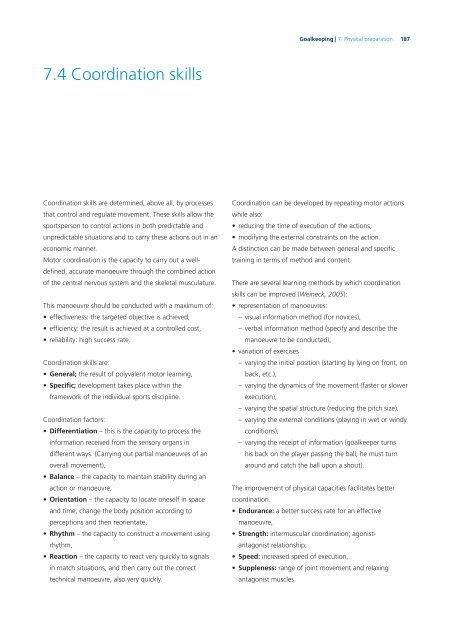Goalkeeping-bok
Goalkeeping-bok
Goalkeeping-bok
You also want an ePaper? Increase the reach of your titles
YUMPU automatically turns print PDFs into web optimized ePapers that Google loves.
7.4 Coordination skills<br />
Coordination skills are determined, above all, by processes<br />
that control and regulate movement. These skills allow the<br />
sportsperson to control actions in both predictable and<br />
unpredictable situations and to carry these actions out in an<br />
economic manner.<br />
Motor coordination is the capacity to carry out a welldefi<br />
ned, accurate manoeuvre through the combined action<br />
of the central nervous system and the skeletal musculature.<br />
This manoeuvre should be conducted with a maximum of:<br />
• effectiveness: the targeted objective is achieved,<br />
• effi ciency: the result is achieved at a controlled cost,<br />
• reliability: high success rate.<br />
Coordination skills are:<br />
• General; the result of polyvalent motor learning,<br />
• Specifi c; development takes place within the<br />
framework of the individual sports discipline.<br />
Coordination factors:<br />
• Differentiation – this is the capacity to process the<br />
information received from the sensory organs in<br />
different ways. (Carrying out partial manoeuvres of an<br />
overall movement),<br />
• Balance – the capacity to maintain stability during an<br />
action or manoeuvre,<br />
• Orientation – the capacity to locate oneself in space<br />
and time, change the body position according to<br />
perceptions and then reorientate,<br />
• Rhythm – the capacity to construct a movement using<br />
rhythm,<br />
• Reaction – the capacity to react very quickly to signals<br />
in match situations, and then carry out the correct<br />
technical manoeuvre, also very quickly.<br />
<strong>Goalkeeping</strong> | 7. Physical preparation<br />
Coordination can be developed by repeating motor actions<br />
while also:<br />
• reducing the time of execution of the actions,<br />
• modifying the external constraints on the action.<br />
A distinction can be made between general and specifi c<br />
training in terms of method and content.<br />
There are several learning methods by which coordination<br />
skills can be improved (Weineck, 2005):<br />
• representation of manoeuvres:<br />
– visual information method (for novices),<br />
– verbal information method (specify and describe the<br />
manoeuvre to be conducted),<br />
• variation of exercises<br />
187<br />
– varying the initial position (starting by lying on front, on<br />
back, etc.),<br />
– varying the dynamics of the movement (faster or slower<br />
execution),<br />
– varying the spatial structure (reducing the pitch size),<br />
– varying the external conditions (playing in wet or windy<br />
conditions),<br />
– varying the receipt of information (goalkeeper turns<br />
his back on the player passing the ball; he must turn<br />
around and catch the ball upon a shout).<br />
The improvement of physical capacities facilitates better<br />
coordination.<br />
• Endurance: a better success rate for an effective<br />
manoeuvre,<br />
• Strength: intermuscular coordination; agonistantagonist<br />
relationship,<br />
• Speed: increased speed of execution,<br />
• Suppleness: range of joint movement and relaxing<br />
antagonist muscles.


